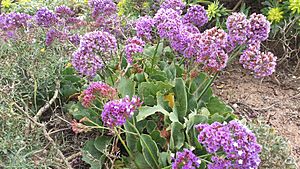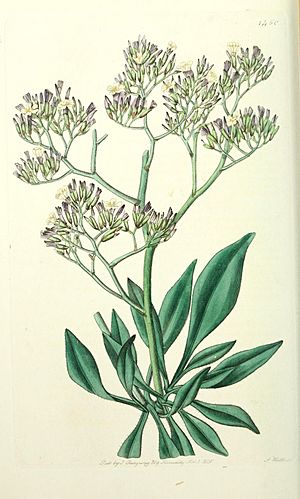Downy sea lavender facts for kids
Quick facts for kids Downy sea lavender |
|
|---|---|
 |
|
| Habit | |
 |
|
| Botanical illustration | |
| Scientific classification | |
| Genus: |
Limonium
|
| Species: |
puberulum
|
| Synonyms | |
|
Statice puberula Webb ex Lindl. |
|
The Limonium puberulum, also known as the downy sea lavender, is a beautiful flowering plant. It belongs to the Plumbaginaceae family, which includes many types of flowering plants. This special plant is found only in the Canary Islands, specifically on the island of Lanzarote.
It grows in subtropical areas, meaning places that are warm all year round but not as hot as the tropics. The name "downy" comes from the soft, fine hairs that might cover its leaves or stems. "Sea lavender" is a common name for plants in the Limonium group, as many of them grow near the sea.
Contents
Where Does Downy Sea Lavender Live?
The downy sea lavender is native to Lanzarote, one of the seven main Canary Islands. These islands are located off the northwest coast of Africa. Lanzarote is known for its unique volcanic landscapes and warm climate.
This plant thrives in subtropical areas, which are warm and sunny. It is an endemic species, meaning it naturally grows only in this specific part of the world. This makes it very special and important to protect.
What Does Downy Sea Lavender Look Like?
The downy sea lavender is a type of flowering plant. It's called "downy" because it might have soft, fine hairs on its parts, giving it a fuzzy feel. The "sea lavender" part of its name comes from its flowers, which often look like lavender, and its tendency to grow near coastal areas.
Scientists have studied this plant closely. They found that while it looks a lot like another plant called Limonium bourgeaui, it is actually a different species. They can tell the difference by looking at the plant's DNA, which is like its unique genetic blueprint.
Why Is Downy Sea Lavender Special?
Being an endemic plant means the downy sea lavender is a natural treasure of Lanzarote. It has adapted perfectly to the island's unique environment. Protecting its habitat is very important to make sure this beautiful plant continues to thrive.
The plant was officially described by scientists in 1891. Its scientific name, Limonium puberulum, helps scientists around the world know exactly which plant they are talking about. The common name, downy sea lavender, is easier for everyone else to use!
See also
 In Spanish: Limonium puberulum para niños
In Spanish: Limonium puberulum para niños

